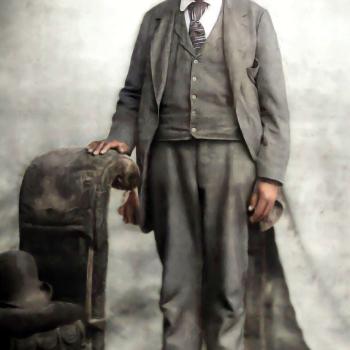 Recently, I reviewed Bart Ehrman’s chapter on the resurrection of Jesus. Basically, Ehrman made the case that (1) historians cannot prove (or disprove) the resurrection of Jesus, but (2) Ehrman finds it highly unlikely that Jesus was actually taken down from the cross and buried. A major plank in his argument for pt #2 is that Ehrman finds it (literally) incredible that the Romans would be so kind and respectful after crucifixion to allow burial. Ehrman doesn’t think there is any proof that a Jew like Jesus would be dignified with a burial, and furthermore, Ehrman believes there is ample evidence that normally the crucified were left exposed and eventually eaten by birds and wild animals or thrown into unmarked common grave pits.
Recently, I reviewed Bart Ehrman’s chapter on the resurrection of Jesus. Basically, Ehrman made the case that (1) historians cannot prove (or disprove) the resurrection of Jesus, but (2) Ehrman finds it highly unlikely that Jesus was actually taken down from the cross and buried. A major plank in his argument for pt #2 is that Ehrman finds it (literally) incredible that the Romans would be so kind and respectful after crucifixion to allow burial. Ehrman doesn’t think there is any proof that a Jew like Jesus would be dignified with a burial, and furthermore, Ehrman believes there is ample evidence that normally the crucified were left exposed and eventually eaten by birds and wild animals or thrown into unmarked common grave pits.
In the response book, How God Became Jesus, the always capable Craig A Evans takes Ehrman on. Now, having read both sides of this story, I have to admit – if I were Bart Ehrman, after reading Evans’ chapter I would be (hmmm…what’s the right euphemism) sweating bricks. In more scholarly terms, Ehrman either was ignorant of some very important textual and archaeological information about the Jewish crucified and executed, or he simply chose to downplay or ignore the evidence against his own theory.
OK, on to the evidence from Evans.
#1: We have ample evidence that the Romans could and did show clemency for the accused and executed (even the crucified). Evans quotes from Septimius Vegetus, Pliny the Younger, and Livy to make his case. But why was mercy shown? “Clemency was sometimes occasioned by a holiday, whether Roman or a local non-Roman holiday, or simply out of political expediency, whatever the motivation” (75-76). Evans goes on to quote from the Roman Digesta which recounts Roman law and practice. In this document it is clearly stated that “The bodies of those who are condemned to death should not be refused their relatives…Even the bodies of those who have been sentenced to be burned can be claimed, in order that their bones and ashes, after having been collected, may be buried.” Further: “The bodies of persons who have been punished should be given to whoever requests them for the purpose of burial.” Bottom line – requests for burial were sometimes taken seriously by the Romans.
Evans does not claim that the Romans always tolerated and kindly responded to requests for burial. They did not. But Evans makes it clear that it matters what the conditions were during the request for burial (so, #2 below).
#2: Romans were more likely to grant a burial request to Jews (a) during peacetime and (b) near Jerusalem. Evans appeals to Philo who recounts to Gaius the normal conditions of respect for Jewish law (Embassy to Gaius 300). Josephus, writes Evans, says much the same (Against Apion 2.73).
Now, Ehrman makes much of the fact that we are talking about Pilate when it comes to the execution of Jesus, and Ehrman believes it improbable that the vicious Pilate would grant a burial request for Jesus. Evans agrees with Ehrman that Pilate had tried to test the patience of Jews earlier in his career (see Josephus, Ant. 18.55-59), but Evans believes Pilate would have learned from their intractability. So, Evans states: “I find it hard to believe that later, acting in concern with the ruling priests in the execution of Jesus, on the eve of Passover, just outside the walls of Jerusalem, he would have defied Jewish law and sensitivities by not permitting the bodies of Jesus and the other two men to be taken down and buried prior to nightfall” (78).
#3: As a member of the Jewish council, someone like Joseph of Arimathea is a natural person to ask for the body of Jesus. Ehrman doubts that someone like Joseph of Arimathea would ask for the body of Jesus, but Evans argues that “The Jewish Council was responsible to oversee the proper burial of the executed because their bodies were normally not surrendered to family and friends” (81). [See further discussion on Joseph on p. 89]
#4: The archaeological evidence points to some crucified bodies being buried. Evans points to bones found in buried ossuaries that demonstrate the some crucified men were buried (such as Yehohanan, discovered in 1968; p. 83). There is also good reason to believe that the legs of this body of Yehohanan were broken- why? – “The most likely and most compelling reason for hastening death in this manner was so that his corpse could be taken down from the cross and placed in a tomb before nightfall, as commanded in the law of Moses (Deut 21:22-23) and as Jewish custom required. The Romans had no reason of their own to expedite death by crucifixion, but they permitted it for reasons discussed above [i.e., to respect Jewish religious law]” (p. 85).
Evaluation
I only listed a handful of illustrations to which Evans appeals to show that Romans did occasionally respect Jewish burial customs, especially near Jerusalem and especially during peacetime. Please read this chapter for yourself, just to see how lopsided Ehrman’s own inklings really are.
Evans cannot prove that Jesus’ body was buried (we don’t have a body, after all!) any more than Ehrman can disprove it, but Evans succeeds in his primary task: to (re)establish that the tale of Jesus told in the canonical Gospels is not fanciful or historically implausible when it comes to the burial of Jesus. (That should be enough, because Ehrman is not after certainty [which is admittedly hard in historical study], but plausibility.)















